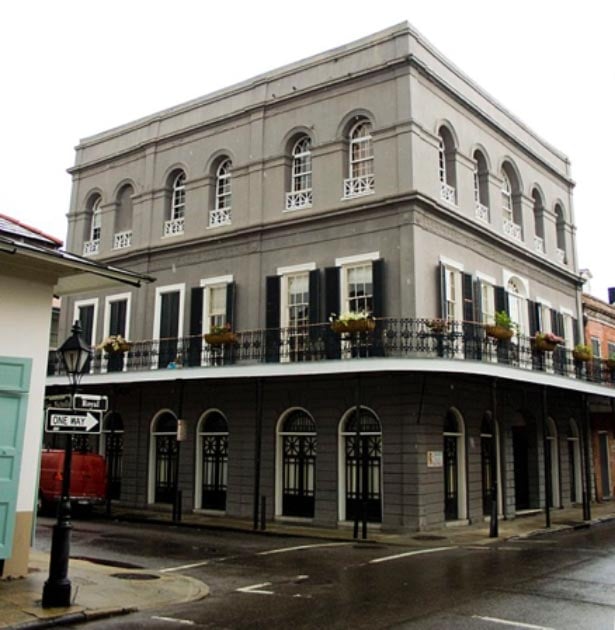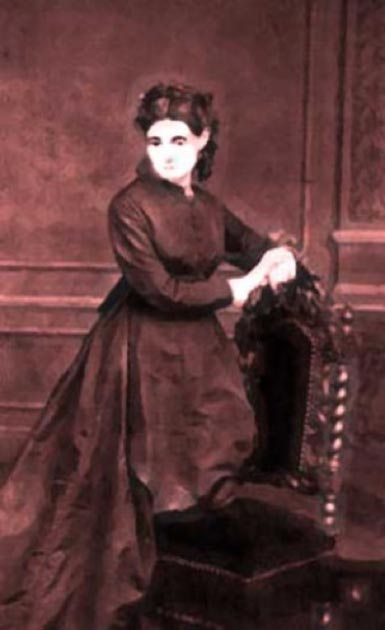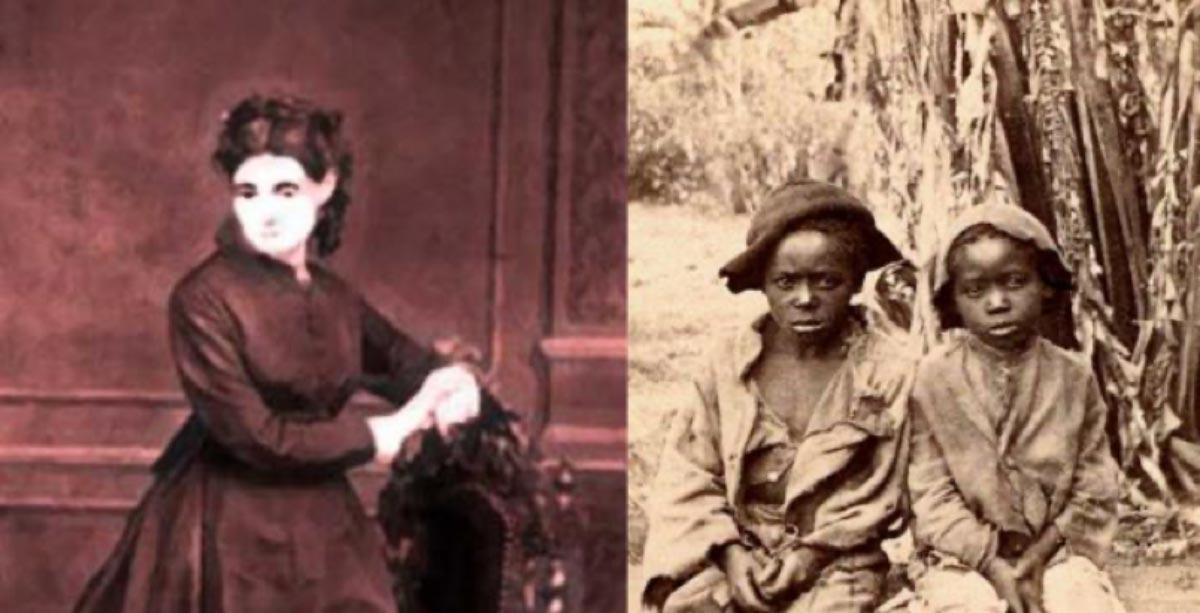Delphine LaLaurie: A Beautiful Face Masks Evil Deeds
Royal Street of New Orleans’ French Quarter is one of the oldest parts of the city, well-known and liked for the many antique shops, galleries, and sights. It remains a window into the real soul of the Crescent City, and reminds us of the true, old-timey character that we all like so much. But what if we told you that the Royal Street kept a much more sinister secret in the walls of its antique houses?
Indeed, the facade of a smiling and lively city hides something dark and macabre, as if copied straight from the darkest horror novel. It is the story of torment, morbid torture, and wanton murder. This is a story of abusive power and foul secrets hidden in plain sight in the city. It is the story of Delphine LaLaurie, New Orleans’ notorious Madame Blanque, and her crimes against her slaves.
Madame Blanque’s story reminds us that people are not always what we expect them to be - beneath an attractive and kind facade, something much more evil and unsettling quivers in the darkness.
- 10 Ancient Serial Killers That Foreshadowed Jack The Ripper
- Elizabeth Bathory – 16th century deranged serial killer or victim of betrayal?
Awakening the Seeds of Evil – The Early Life of Delphine LaLaurie
As you stroll down the old French Quarter of New Orleans, you come to the corner of Governor Nicholls Street and Royal Street, where you will quickly be shadowed by a tall, imposing mansion. It’s a gray, square building that bears the ghastly epithet of “The Haunted House.” But even though its gray walls perfectly fit the role, it is sadly not the original home of Mrs. LaLaurie. It was just erected on the same site.

The LaLaurie residence in 1140 Royal Street, New Orleans, photographed in September 2009. (Dropd/CC BY SA 3.0)
But even so, standing at that corner you can quickly immerse yourself into the peculiar setting of LaLaurie’s story, returning with surprising haste into the mid 1800’s and the blinding splendor of old New Orleans. Getting drunk on the dazzling city lights, enchanted by the night life and the richness of the upper class, floating in the sea of smiles and laughs and champagne - without a single clue about the events that are happening in the attic of an imposing gray building right across the street. That was exactly the feeling that the citizens of the French Quarter experienced, and the friends and visitors of Delphine LaLaurie, who walked the hallways of her sprawling corner street mansion without even knowing what went on in the upper floors.
Delphine LaLaurie was born as Marie Delphine MacCarthy on March 19, 1787. Her grandfather, Barhelemy MacCarthy, emigrated from Ireland to New Orleans around the 1730’s. Delphine’s father settled into New Orleans society and married a French or Creole woman named Marie Jeanne L’Erable, a somewhat well-situated widow. In short, Delphine’s parents were wealthy and somewhat influential in society. This paved an easy way for their offspring, including Delphine.
Delphine first married when she was about 23 years old, in 1800, to Don Ramon de Lopez y Angulo, a prominent Spanish royal officer, a Caballero de la Royal de Carlos. At the time, Louisiana, including New Orleans, was under Spanish control. Sadly, her marriage lasted only about four years, as her husband fell ill on an ocean voyage and died in Havana, Cuba, leaving behind him a pregnant Delphine.
Just four years later, Delphine’s heart was sufficiently mended for her to find a new suitor. This time it was Jean Blanque, a wealthy New Orleans merchant, banker, and lawyer. It was at this time that the newlyweds moved to Royal Street. Together they had four children, but Monsieur Blanque, sadly, died just eight years into the marriage, in 1816. Madame Blanque, as Delphine was now known, was once again a widow.

Delphine LaLaurie. (Public Domain)
This time she remained a widow for several years, nine to be exact, until she married for the third time, in June 1825, to a man named Leonard Louis Nicolas LaLaurie, a physician. Six years into their marriage, Delphine LaLaurie bought the aforementioned mansion on Royal Street – a house which would become a notoriously cruel place in the French Quarter. The house was converted into a two-storied mansion and had attached slave quarters.
Rumors Begin Surfacing
The LaLaurie’s became a central piece of New Orleans’ high society at the time. The upper class knew them as wealthy, and miss LaLaurie as a socialite, a lady of experience. As was the custom at the time, lavish dinners were held at the LaLaurie mansion, balls too, perhaps. And it was during that time that the wealthy and influential guests began having doubts about their hosts.
The LaLaurie’s owned slaves. They were house servants and did most jobs that needed doing, from cooking to serving. But there was something that seemed especially unusual in the mansion. Gossip quickly spread like wildfire and people spoke of the odd atmosphere in the mansion.
The slaves were remarkably haggard they all said, wretched and despondent, seemingly afraid of everything. The house had a noticeably grim ambience, a veil of misery seemed to permeate all corners of it. LaLaurie kept a persistent mask of politeness and civility towards her slaves, but they remained an image of fright and horror. Tales soon spread and noses poked around the household, investigating the rumors that Mrs. Delphine LaLaurie was somehow seriously mistreating her slaves.
These same rumors caused a local lawyer to be commissioned and dispatched to the LaLaurie mansion, seemingly to remind the owners of ‘proper conduct’ towards house slaves. After that, the rumors kept spreading - LaLaurie was somehow mistreating her slaves. It was around this time that a gruesome scene was witnessed by some neighbors and circulated in the society.
On one evening, several witnesses saw a grim scene - a furious, hell-bent Delphine LaLaurie, whip in hand, pursuing a frightened slave girl to the roof of the mansion. The girl, in her fright, fell from the roof and perished. The story goes that the girl was brushing her mistress’ hair, hit a knot, and caused her discomfort. Delphine LaLaurie saw it fitting to whip her bloody for this misdeed, but the girl instead leapt to her death. The body was buried in partial secrecy on the LaLaurie mansion grounds. The girl was just 12 years old.
This sad occurrence was the catalyst that prompted an investigation by the officials. The first observations confirmed that, indeed, the LaLaurie’s were cruelly mistreating their slaves. The investigation forced them to let go of nine of these slaves. But, pulling on some family connections, these same nine slaves were re-bought and brought back to their former place of residence - the dreaded LaLaurie mansion.
- Killer Queen: Meet Queen Elfrida – The Original Wicked Stepmother
- La Quintrala: Flaming Redhead Serial Killer Evaded Capture
A Fire of Desperation
Then the mysterious happenings at the mansion unraveled in the most ominous way possible. Quite literally like fire. Everything went sour for Mrs. LaLaurie on April 10th, 1834, when a fire broke out in the mansion in the kitchen. It prompted the quick arrival of the police and the fire brigade, who were shocked by what they discovered on the premises. The source of the fire was in the kitchen, where an elderly female slave was chained by her ankle to the cooking stove.
She said that it was she who had started the blaze, in a last ditch attempt to commit suicide. She was getting old, she said, and feared that she would be taken to the uppermost room. And slaves that go to the uppermost room, she said, never come out again. The chained woman also said that she was perpetually behind the stove, and that her daughters were strictly forbidden to feed the slaves or unshackle her. All were malnourished and afraid.
A curious report was penned on April 11th, 1834, in the New Orleans Bee, further unraveling the story. All those who gathered to quench the flames wanted to enter the slave quarters and evacuate all the people inside. The LaLauries refused to allow them to enter. The firemen and the law proceeded to break inside the slave quarters and the uppermost room, to their dismay.
They were shocked by the morbid discovery of what lay inside. Several slaves were kept there, horribly mutilated, suspended by their limbs in a grotesque display of human suffering. Some were hung by their necks, and all had their arms and legs torn and stretched abnormally. Two men were kept in tiny cages, while two elderly women were horribly wounded and unable to move. All of the people showed signs of severe whipping and many had crude iron collars around their heads which prevented them from lying down to sleep.
The law immediately enquired about the scene at hand, upon which the LaLauries took up a defensive stance, insolently stating that “some people should best stop meddling in the affairs of others.”

Madame Delphine LaLaurie's attic, Musée Conti, New Orleans, Louisiana, USA. (Teresa Morrison/CC BY NC 2.0)
None of it was satisfactory to the mob though, and when a mob discovers a mission of its own, naught can stand in the way. Horrified by the discovery of the abused slaves, the mob stormed the LaLaurie mansion and wrecked it. The sheriff attempted to disperse the mob in vain.
When he arrived the house was demolished, with only the walls still standing. The abused slaves were taken to the local jail, where in a strange unfolding of events, they were “exhibited” for public viewing, so that all the locals could learn of their abuse. Two of the slaves were in too weak of a condition and died soon after their rescue. For several weeks after the destruction and fire the officials conducted a thorough sweep of the estate, even digging in the yard. They exhumed several sets of human remains, including those of a child.
Delphine LaLaurie and her husband were quick to flee the scene. During the mob’s demolishing of their mansion they escaped on foot and carriage, fleeing to the waterfront and from there to Mobile in Alabama, and then to Paris.
Delphine LaLaurie’s fate is veiled in mystery, but all sources suggest she eventually died of old age in Paris. A copper plate was discovered in the 1930’s in the St. Louis Cemetery, which stated that Delphine LaLaurie MacCarthy had died in Paris on December 7th, 1842.

Black and white photograph of copper plate found in St. Louis Cemetery #1 by Eugene Backes in the late 1930s. Text reads: "Madame Lalaurie, nee Marie Delphine Maccarthy, decedee a Paris, le' 7 decembre, 1842, a l'age de 6 --." (Fair Use)
Later on it was discovered in the French archives in Paris, that Delphine LaLaurie MacCarthy died on December 7th, 1849, aged 62. Whether or not she died in poverty or wealth, haunted by her deeds or indifferent to them, we will never know. She fled from her New Orleans life and the cruelty she inflicted upon others. The monstrous woman had around 15 years to bear that burden on her shoulders, if it did burden her at all.
- Body Snatchers and Tortured Spirits: The Dark History of the South Bridge Vaults of Edinburgh
- Prisons and Imprisonment in the Ancient World: Punishments Used to Maintain Public Order
LaLaurie’s mansion remained a ghastly ruin for some years after the mob’s destruction. It stood there as a macabre and ominous reminder of the crimes of its previous occupants, and transformed the dazzling nightlife of New Orleans’ French quarter by ruining its grandeur with its charred and lifeless husk. But the house was eventually purchased by Pierre Trastour, who rebuilt it and gave it the look it has to this day.
Since then, the house of torment has had many roles. It was a public high school, a bar, an apartment building, a furniture store, and more. None of these new roles did much to erase the history that seemed to haunt this corner. Blood and torment are difficult to remove.

Delphine LaLaurie Mansion on a 1906 postcard. (Public Domain)
The LaLaurie mansion was bought by the actor Nicolas Cage in 2007, for a sum of $3.45 million. It was auctioned off just two years later, for a sum of $2.3 million.
Unpunished
In the decades that followed these occurrences, the crimes of Delphine LaLaurie were greatly augmented. They became a part of local folklore and each new retelling brought more gruesome details. The number of abused slaves climbed up to a hundred, and crimes were bordering the realm of impossible.
Either way, the true, documented crime of Delphine LaLaurie and the sad fate of those slaves that she abused in the most macabre ways remains a testament to the cruelty of some people, and an important insight into the minds of humans with an inherent desire to kill, maim, and mutilate, for reasons known only to them.

Madame Delphine LaLaurie. (Public Domain)
Top Image: Delphine LaLaurie (Public Domain) and children of slaves in the American South. (Okinawa Soba (Rob)/CC BY NC SA 2.0)
By Aleksa Vučković
References
Casale, S. 2019. Madame Delphine LaLaurie: The Most Evil Woman in New Orleans. The Lineup. [Online] Available at: https://the-line-up.com/madame-delphine-lalaurie
Fitzhugh, P. 2009. Ghostly Cries from Dixie. The Armand Press.
Wigington, P. 2019. Delphine LaLaurie: Biography and History of the LaLaurie Mansion. ThoughtCo. [Online] Available at: https://www.thoughtco.com/delphine-lalaurie-4684656




















Comments
I’m fascinated by Mme. LaLaurie’s crimes, but I have a question. If she was born in 1787 and married for the first time in 1800, she would have been 13, not 23. So, are the dates wrong, or is the age a typo? Other than that, good read.
I love accuracy.